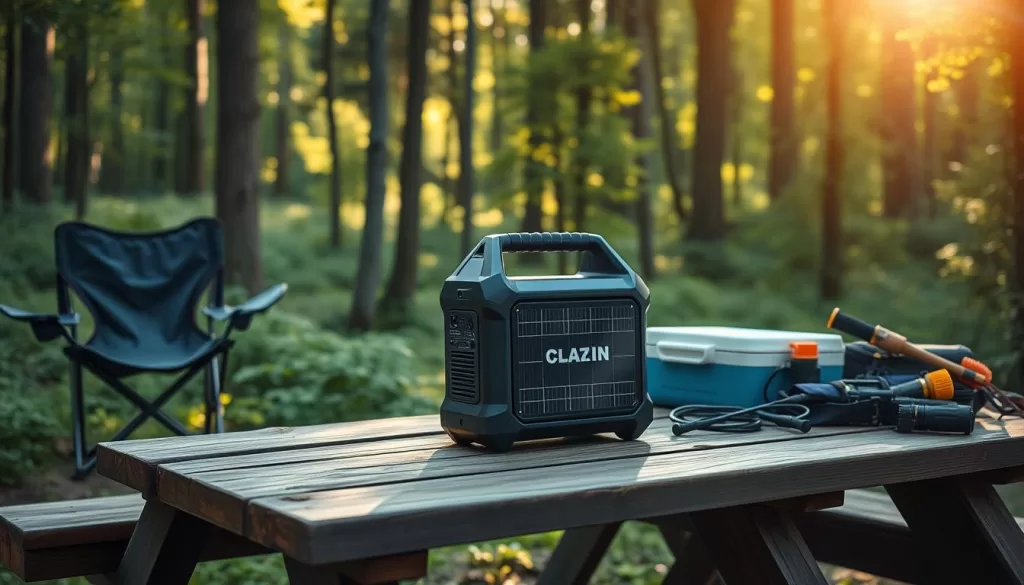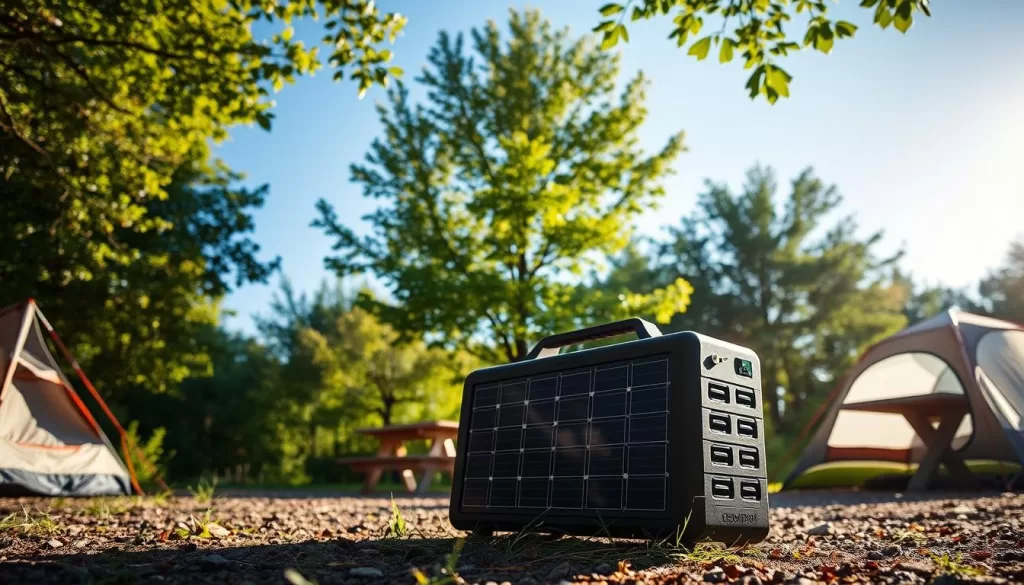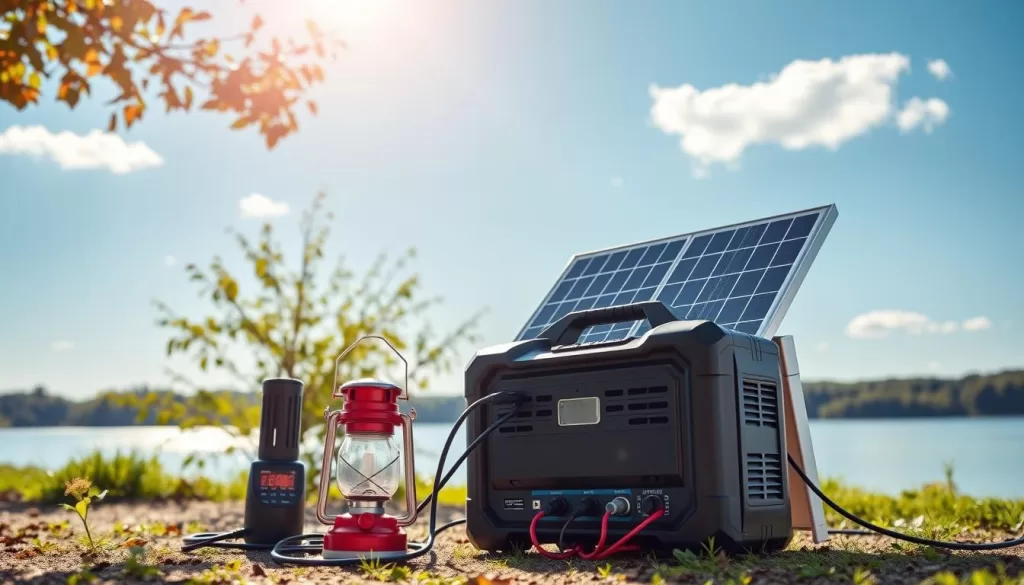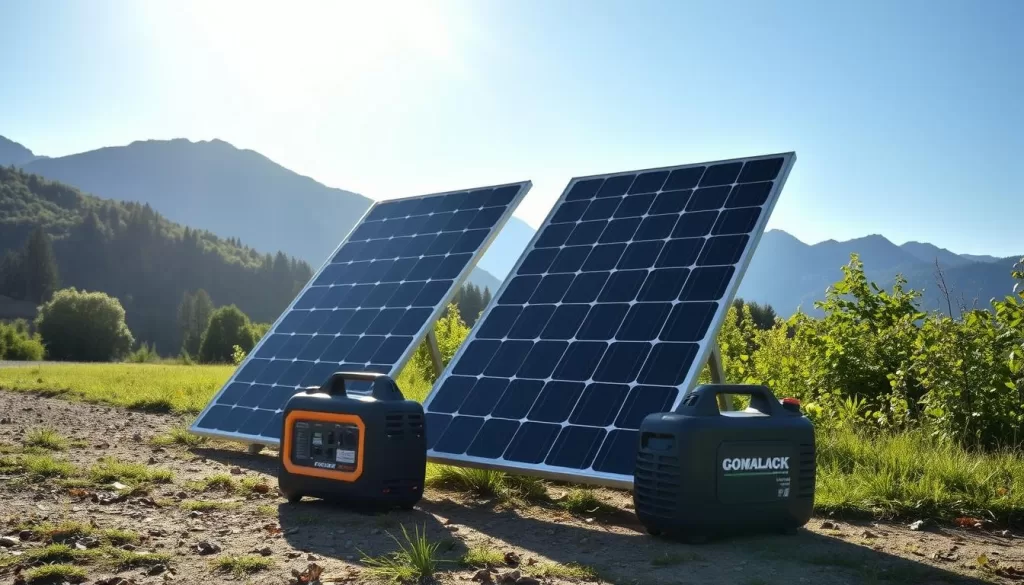Portable Solar Generator: Powering Your Outdoor Experiences
When we venture into the outdoors, we often need a reliable power source. Portable solar generators offer a clean, renewable option instead of traditional fuel generators. They use the sun’s energy, making them a great choice for outdoor projects1. We’ll look at the benefits and uses of these generators, including for camping and hiking. We’ll also help you pick the right one, like the Yoshino K6SP11, priced at $685.002.
Portable solar generators are key for outdoor lovers, providing a green power solution. They’re especially popular for camping, which now focuses on being eco-friendly1. With a portable solar generator, you can run small appliances and charge many devices. They’re perfect for any outdoor adventure.
Page Contents
- 1 Understanding Portable Solar Generators: Your Gateway to Off-Grid Power
- 2 Essential Features of Modern Portable Solar Generators
- 3 Power Output and Capacity: What You Need to Know
- 4 Top Applications for Your Portable Solar Generator
- 5 Choosing the Right Size for Your Needs
- 6 Setting Up and Operating Your Solar Power Station
- 7 Maintenance Tips for Long-Term Reliability
- 8 Weather Considerations and Performance Optimization
- 9 Safety Features and Best Practices
- 10 Conclusion: Embracing Sustainable Portable Power
- 11 FAQ
- 11.1 What are the key components of a portable solar generator?
- 11.2 What are the benefits of using a portable solar generator over a traditional fuel-powered generator?
- 11.3 How do I choose the right size of portable solar generator for my needs?
- 11.4 How do I set up and operate my portable solar generator?
- 11.5 How do I maintain my portable solar generator for long-term reliability?
- 11.6 How do weather conditions affect the performance of my portable solar generator?
- 11.7 What safety precautions should I take when using a portable solar generator?
- 12 Source Links
Key Takeaways
- Portable solar generators provide a reliable and sustainable power source for outdoor activities.
- They offer a clean and renewable alternative to traditional fuel-powered generators.
- Portable solar generators are ideal for camping, hiking, and other outdoor activities.
- They can power small appliances and charge multiple devices.
- Off-grid solar generators and solar powered generators are essential tools for outdoor enthusiasts.
- Portable solar generators are a game-changing power system for outdoor workshops and DIY projects1.
- The Yoshino K6SP11 Portable Solar Generator has a sale price of $685.002.
Understanding Portable Solar Generators: Your Gateway to Off-Grid Power
Portable solar generators are key for off-grid power. They turn sunlight into electrical power using photovoltaic cells. This power is then stored in a battery bank3. They are great for outdoor activities and emergencies.
The main parts of a solar power system are solar panels, a battery bank, and an inverter. Solar panels turn sunlight into power. The battery bank stores this power. The inverter makes the power usable for your devices. With a solar energy generator, you can power many things like electric grills and air conditioners4.
Solar generators are better than traditional ones because they’re eco-friendly and quiet. They also need little maintenance. Solar panels can cut electricity costs by up to 70%5. The demand for solar generators is growing fast, with a 10.7% annual growth rate expected from 2023 to 20305.
When picking a portable solar generator, look at its power output and capacity. A higher output means you can power more devices for longer. For example, a 600-Wh solar generator can power a 50-watt light for 12 hours or two 100-watt devices for three hours4. Knowing what makes a good portable solar generator helps you choose the right one for your needs.
| Device | Power Consumption | Runtime |
|---|---|---|
| 50-watt light | 50 watts | 12 hours |
| 100-watt device | 100 watts | 6 hours |
| TV and Nintendo Switch | 116 watts | 7 hours |
Essential Features of Modern Portable Solar Generators
Choosing a portable solar generator requires careful consideration. A compact solar generator is perfect for outdoor adventures because it’s light and easy to carry. A solar power station with a big battery is key for charging devices and appliances. The EcoFlow RIVER 2 Pro, tested in 20246, weighs 17.8 lbs and stores 768 Wh, ideal for camping and hiking.
The power output of a mobile solar generator is crucial. Outputs range from 800 W to 3,000 W6. Prices vary from $549 to $3,2996, so pick one that fits your needs and budget. The Geneverse HomePower 2, for example, has a vertical design for better indoor safety7.
Here are some key features to consider when choosing a portable solar generator:
- High-capacity battery
- High-power output
- Compact and lightweight design
- Easy to transport and set up
Popular models like the Jackery Explorer 3000 Pro offer 3000W output and 3024Wh capacity8. The best portable solar generator for you depends on your specific needs and preferences.
| Model | Weight | Energy Storage |
|---|---|---|
| EcoFlow RIVER 2 Pro | 17.8 lbs | 768 Wh |
| Anker SOLIX F2000 | 2048 Wh | |
| OUPES 1200 | 24.3 lbs | 992 Wh |
Power Output and Capacity: What You Need to Know
When picking a portable solar generator, think about its power output and capacity. This ensures it fits your needs. For instance, a typical Canadian home uses about 31 kWh of electricity each day9. To figure out your needs, use the formula: Volts (V) x Amps (A) = Watts (W)9.
A portable solar energy system is great for outdoor fun. Think about what you need to power, like a fridge/freezer. It uses about 700 running watts and up to 2,200 starting watts9. A solar power kit can guide you to the right battery size and how long it will last.
Here’s a table to estimate power needs for common items:
| Appliance | Running Watts | Starting Watts |
|---|---|---|
| Refrigerator/Freezer | 700 | 2,200 |
| Washing Machine | 1,200 | 2,300 |
| Vacuum | 1,440 | 2,500 |
An emergency solar backup keeps you safe during blackouts. Look for a solar generator with lots of capacity, like the EcoFlow DELTA Pro. It has 3.6 kWh of battery and can charge up to 1,600 W from the sun9. The right portable solar energy system means reliable power for your adventures.
Top Applications for Your Portable Solar Generator
Our portable solar generators are great for many things. You can use them for camping, hiking, outdoor events, and even as a backup power source. They offer a reliable and green off-grid power supply10. They’re perfect for those who love the outdoors and want to power their gear without using fuel.
Using a portable solar generator means you can enjoy the outdoors more. It also helps the environment by reducing carbon emissions.
Some of the most popular uses for these generators include:
- Camping and hiking, where they can be used to charge devices and power camping equipment
- Outdoor events, such as festivals and concerts, where they can be used to power sound and lighting systems
- Emergency backup power, where they can be used to provide power during outages and natural disasters
They’re also great for small appliances like refrigerators and air conditioners. These use between 100 to 400 watts11. You can power them with arenewable energy generatoror abattery powered generator10.
In summary, portable solar generators are a flexible and dependable choice for anyone needing a green and off-grid power supply10. They’re perfect for outdoor lovers, event planners, and anyone looking to cut down on traditional energy use.
| Application | Power Requirement |
|---|---|
| Camping and Hiking | 10-50W |
| Outdoor Events | 100-1000W |
| Emergency Backup Power | 100-5000W |
Choosing the Right Size for Your Needs
When picking an outdoor solar generator, think about the size you need. You must consider how much power and capacity you require. For example, small systems under 500W are great for short trips or emergencies. They can power small devices like phones or laptops12.
For more power, like charging mini fridges or LED lights, choose a system between 500W-1500W. This size is perfect for weekend trips or as a home backup12. Larger systems over 1500W are best for long camping trips or off-grid living. They can handle bigger appliances like small heaters or electric blankets12.
Always calculate your total wattage needs and add 20% for devices with high starting wattage12. This ensures your solar generator can power all your devices without issues. By picking the right size, you get a reliable power source for adventures or home use13.
Some models, like the Jackery Solar Generator 1000, have a 1070Wh battery and 1500W surge power. They’re great for charging mini fridges and coolers13. Others, like the Jackery Solar Generator 2000 Plus, can expand from 2kWh to 24kWh. They’re designed for charging both large and small appliances13. Remember, the size and weight of solar generators vary, so choose wisely based on your needs14.
| Power Station Size | Capacity Range | Suitable For |
|---|---|---|
| Small | 100-500Wh | Short trips, emergencies |
| Medium | 500-1500Wh | Weekend getaways, home emergency power |
| Large | 1500-3000Wh | Extended camping trips, off-grid living |
| Extra Large | 3000Wh+ | Long-term RV use, backup power during emergencies |
Setting Up and Operating Your Solar Power Station
Setting up your solar power generator is key to its performance15. First, figure out how much electricity you use each month. For most American homes, it’s around 886 kWh15. Knowing this helps pick the right solar power generator, like EcoFlow’s DELTA Max or DELTA Pro, which vary in power15.
For the best results, place your solar panels right for sunlight. This boosts your solar power generator’s efficiency, a vital part of an off-grid system16. Keep an eye on how well your system works to spot and fix any problems.
Important things to think about when setting up and using your solar power station include:
- Calculate your energy needs based on your appliances’ wattage
- Pick the right solar panels and generator size for you
- Put your solar panels in the best spot for sunlight
- Check your system’s performance often to keep it running well16
By following these steps and thinking about your energy needs, you can set up and use your solar power station well. This way, you get the most out of your renewable solar energy system15.
Maintenance Tips for Long-Term Reliability
To keep our portable solar panel system working well for years, we need to do regular maintenance17. This means cleaning the panels, checking the battery connections, and storing the generator in a dry, cool spot. These simple steps help avoid damage and keep the system running at its best18.
Some important maintenance tasks for our solar power bank include:
- Regular cleaning of the solar panels to remove dust and debris, which can reduce efficiency by up to 25%18
- Checking and maintaining the battery connections to prevent corrosion and ensure reliable energy storage17
- Storing the generator in a dry and cool location, away from direct sunlight and moisture, to prevent overheating and damage17
It’s also key to keep an eye on the battery’s charge and avoid deep discharges. This helps the battery last longer18. By taking care of our portable solar panel system, we can enjoy reliable, sustainable power for many years17.
Regular maintenance not only extends the life of our solar generator but also boosts its efficiency. This means we need fewer repairs and replacements18. It also saves us money and helps the environment, making our solar system a great choice for outdoor lovers and those needing reliable emergency power17.
Weather Considerations and Performance Optimization
When using a solar backup generator, it’s key to think about the weather. In hot places, solar panels work less well in summer because they get too hot19. But, places with mild weather are best for solar power, as it works well all year19. To get the most out of your generator, follow seasonal tips and keep it in a cool, dry spot.
A lightweight solar generator is great for off-grid power, but weather can impact it. Solar panels work less well when it’s over 25°C (77°F)19. Also, cloudy areas get less sun than sunny ones, affecting solar panel efficiency19. Pick a spot with good air flow and not too many clouds.
Using weather monitoring systems, like those from Columbia Weather Systems20, can help. They let you see the weather and adjust your generator’s settings. Some generators, like the EcoFlow DELTA Pro, can make up to 7,500 watts of power21. By picking the right generator and optimizing it, you get reliable, efficient off-grid power.
| Solar Generator Model | Capacity | Energy Output |
|---|---|---|
| EcoFlow DELTA Pro | 3.6 kWh (expandable to 25 kWh) | Up to 7,500 watts |
| EcoFlow RIVER 2 Pro | 768 Wh | Up to 500 watts |
Safety Features and Best Practices
Using a portable solar panel generator safely is key. It’s great for camping, hiking, or when the power goes out22. Keeping it in good shape is important, and this can depend on the model22. Don’t overload it, as this can cause problems22.
Store your generator in a cool, shaded spot to keep it working well22. Keep it away from direct sunlight and humid places22. Store it between 50°F and 80°F to protect the battery22. Always charge it as the maker says to avoid damage22. The Geneverse SolarPower ONE has passed 48 tests, showing it’s safe and reliable23.
Here are some tips to keep your generator safe and working well:
- Always follow the manufacturer’s instructions for maintenance and operation.
- Use the generator in a well-ventilated area, away from flammable materials.
- Keep the generator out of reach of children and pets.
- Regularly inspect the generator and its components for damage or wear.
By following these tips, you can use your portable solar panel generator safely and efficiently. It will be a reliable power source for your needs.
| Generator Model | Capacity | Output |
|---|---|---|
| Geneverse SolarPower ONE | 200W | 100W minimum output |
| Goal Zero Yeti 1500X | 1,516Wh | varies by device |
A portable solar panel generator is a great addition to any renewable energy system. It’s perfect for many uses. Choose a reliable model like the Geneverse SolarPower ONE and follow safety rules to enjoy its benefits safely23.
Conclusion: Embracing Sustainable Portable Power
When we go on outdoor adventures, portable solar generators are the perfect choice. They give us reliable power without harming the environment. By using the sun’s energy, we can charge our gadgets and appliances without pollution24.
The latest solar generator tech, like the EcoFlow RIVER series, is even better. It’s more efficient, lighter, and easier to use than before24.
Choosing a portable solar generator is more than just a convenience. It’s a step towards a greener future25. These systems can save you money over time by cutting down on fuel or electricity costs. Plus, many governments offer perks for using renewable energy25.
They also work quietly and need little upkeep. This makes them perfect for camping, hiking, or any outdoor activity26.
Let’s use the sun’s power for our next adventure. With a portable solar generator, we can explore off the grid. We can keep our devices charged and stay connected in an eco-friendly way26.
FAQ
What are the key components of a portable solar generator?
What are the benefits of using a portable solar generator over a traditional fuel-powered generator?
How do I choose the right size of portable solar generator for my needs?
How do I set up and operate my portable solar generator?
How do I maintain my portable solar generator for long-term reliability?
How do weather conditions affect the performance of my portable solar generator?
What safety precautions should I take when using a portable solar generator?
Source Links
- Portable Solar Generators: Power Stations + Solar Panels | Goal Zero
- Yoshino K6SP11 Solid-State Portable Solar Generator – Yoshino Power
- How to Choose a Portable Power Station: Gas and Solar Generators | Thunderbird Disco Homestead – Permaculture Homesteading Blog
- How to Choose a Portable Solar Generator | Lowe’s
- Solar Generators 101: Harness Sun Power Now!
- Best Solar Generators: Pros and Cons from Our Expert Testing
- Top 5 Design Features of the Solar Generator Made for Modern Homes
- Solar Generator vs. Portable Power Station vs. Solar Panel: What is the Difference – Jackery
- What Size Solar Generator Do You Need to Run a Whole House?
- Using a Portable Solar Generator for Your Garden
- Top 6 Applications And 5 Pros of Solar Generators
- How to Select the Right Size Portable Power Station For Your Needs
- What Size Solar Generator Do I Need? For House, Camping, Camper and More – Jackery
- Size a Portable Solar Generator
- How to Set Up a Solar Backup Generator: A Step-by-step Guide
- How to Build Your Own DIY Solar Generator?
- Tips on Solar Generator Maintenance
- How to Extend the Life of Your Solar Generator
- Solar Panel Efficiency: Climate & Positioning Tips | RxSun
- Weather Data to Optimize Solar Power
- Does a Solar Powered Generator Work in the Winter? – EcoFlow US Blog
- Taking Care of Your Portable Solar Generator: Ultimate Guide to Maintenance
- Everything You Need to Know About Buying a Solar Generator
- The Future of Renewable Energy: Solar Generators Explained
- Game-Changing Portable Power: Why You Need a Solar Generator Today
- Exploring the Benefits of Portable Solar Generators_LK Power Electronics







